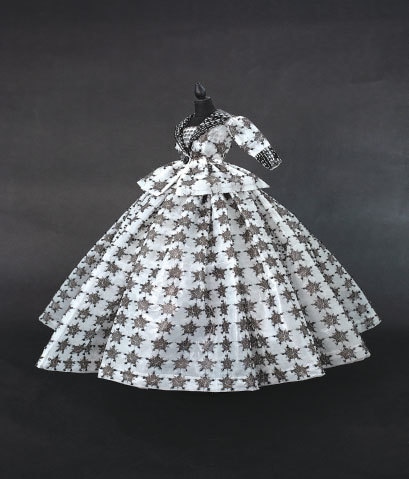Bushra Waqas Khan’s artworks blend finesse and pithy commentary on our colonial legacy. Her interdisciplinary approach pushes the boundaries of what art can be. Khan’s miniature-sized Victorian dresses and gowns are replete with motifs drawn from affidavit paper. The ubiquitous chaand tara motif replaces the gingham and chintz patterns commonly associated with European dress.
While she has won accolades at gallery shows, Khan has also been making waves for winning an award at the ADA Awards 2020-21 and for being nominated for the prestigious Victoria & Albert Museum Jameel Prize this year.
Khan sat down with Eos for an interview about how that came about and her practice. The following are excerpts from it…
How does it feel to be shortlisted as a finalist for the Victoria & Albert Museum Jameel Prize?
It was a real surprise! Normally, artists are nominated by someone, and they have to have years of experience, portfolios, etc. behind them. This year it was an open call, so I applied. I am so grateful for this opportunity that has been given to me.
You graduated as a printmaker from the National College of Arts, Lahore. How and when did your practice transform?
A well-known artist and curator, Adeel uz Zafar, was visiting my husband’s studio and happened to ask if I was practising as well. Although the birth of my kids and motherhood had transformed my life, I had been working consistently but had not shown my work to anyone or exhibited. I showed him this little black dress and jacket I was working on for myself. After a couple of months, Zafar contacted me saying he would like me to be part of a group show at AAN Gandhara Art-Space called Microcosm.
Bushra Waqas Khan opens up about her recent nomination for the V & A Museum Jameel Prize, and what inspired her to create delicately crafted, miniature dresses that look like affidavit paper
Keeping the title of the show in mind, I started making these small dresses. It fascinated me that people at the show thought my dresses were made out of paper, when it was net and silk! For my show at Canvas Gallery, I started using organza, which was also mistaken for paper, so this illusion and drama in my work is what I have continued to play with.
Was the initial use of the pattern and design of affidavit paper an aesthetic choice, or borne out of conceptual concerns?
Both I think. To me it is not just a piece of paper. In terms of concept, the document is a marker of possession. Whether you are getting married, divorced or want to possess land, it will involve signing an affidavit. Seen this way, it is then a part of every household — our lives revolve around it. The paper is passed down from generation to generation…it is a never-ending exchange, like an heirloom. But it also overpowers us, because it carries the promise of wealth, joy, sadness: it carries the weight of time.

So what happens when such possessions become your attire? I was also considering how women, like the dresses I make, are regarded as possessions meant to be passed from one hand to another… except that I wish women in our society were taken care of and valued as much as that piece of paper!
In terms of design, I was fascinated because it takes me back to my practice as a printmaker. If you look closely, the left side is not entirely equal to the right side. Perhaps so it cannot be forged? There is a whole system behind the construction, craftsmanship and composition of the affidavit, which is there to be decoded. When people look at my little dresses they should feel the same way. There is much to discover, because I can manipulate and end up surprising the viewer in the end.
Why opt for European dresses?
If you remove the chaand tara motif from the affidavit, the flowing scroll design is very European. The affidavit is a fusion of East and West. Constant invasions and colonisation by the British has left its mark on our culture. So the dresses also represent this fusion of culture, and the presence of the coloniser.
What is a regular day in the studio like for you?
I work with a team. I have an expert who executes my patterns and cuts. I also have an embroiderer and, if the workload is immense, I call in more embroiderers. The work requires time, labour and research, because the dresses are tiny and have even tinier waists — draping them is a very laborious process, since metres of fabric have to be scrunched together on a tiny mannequin.
The designs are first made on heat-transfer paper. They are then transferred on to fabric using a technique involving metal plates. I use silk, cotton and organza. I make prototypes in cotton on tiny mannequins. I like using organza because it is thin and light. Every day is a challenge. Sometimes the weight of my dresses can be daunting. For example, for one of my dresses for the show titled Red Carpet, we discussed how we can control the contours of a skirt if we look at how the contours of a kite are formed with paper.
Published in Dawn, EOS, April 18th, 2021















































Dear visitor, the comments section is undergoing an overhaul and will return soon.